Living Lab for the Diffusion of Enabling Technologies in Agriculture: The Case of Sicily in the Mediterranean Context
Abstract
1. Introduction
- Co-creation and user involvement: LLs encourage active participation and co-creation between farmers and end-users in the development and testing of enabling technologies. By involving farmers in the design process, understanding their needs and incorporating their feedback, technology developers can customise solutions to better meet the requirements of farming practices.
- Demonstrations and field trials: In LLs, farmers can observe the practical application of these technologies, interact with experts, and gain hands-on experience in using the tools within their own farming operations. This hands-on approach enhances learning and facilitates technology adoption.
- Knowledge sharing and networking: Farmers can learn from colleagues, researchers and technology providers, benefiting from different perspectives and best practices in technology adoption and implementation.
- Training and capacity building: They offer training programmes and capacity-building initiatives to improve farmers’ technical skills and knowledge in the use of KETs.
- Feedback mechanisms and iterative improvement: They facilitate continuous feedback loops and iterative improvement processes to refine and optimise KETs.
- Political engagement and advocacy: They serve as platforms to engage policymakers, practitioners, and regulators in discussions related to KETs in agriculture. By showcasing the benefits and outcomes of technology adoption within living labs, stakeholders can advocate for supportive policies, funding mechanisms, and regulatory frameworks that promote innovation in agriculture.
- What are the main challenges and specific barriers faced by Sicilian farmers in the citrus-, olive-, and wine-growing sectors in adopting KETs, and to what extent do these vary between different production sectors?
- Which socio-economic factors, including availability of incentives, digital infrastructure, and technical skills, influence the adoption of KETs in the Sicilian agricultural sector, and how do these elements affect the degree of innovation in different production sectors?
- What customised strategies can be implemented to foster widespread and sustainable KET adoption in the main Sicilian agricultural sectors, considering the different levels of perceived usefulness and sectoral priorities in terms of efficiency, quality, and revenue stability?
2. Materials and Methods
2.1. Context in Which the Study Was Carried Out
2.2. Living Lab as a Tool for the Co-Construction of Innovation Needs
- Identify the main factors influencing the adoption of innovations by actors in the various supply chains;
- Identify potential barriers to the diffusion of such innovations at the local level;
- Facilitate the scalability of innovations to other communities and promote large-scale diffusion;
- Support decision-makers in defining strategies for the ecological and digital transition of the agricultural sector.
2.3. Tools Used
3. Results
3.1. Propensity for Innovation Through KETs
- Strategic Plan for Innovation and Research in Agriculture, Food and Forestry (2014–2020): Approved by Decree of the Ministry of Agriculture, Food and Forestry (Mipaaf) No. 7139 of 1 April 2015, this plan established a specific Working Group for precision agriculture, which drew up guidelines for the sector. This provided a solid basis for the adoption of innovative techniques in Italian agricultural practices.
- ISMEA Incentives for Agricultural Innovation: The Istituto di Servizi per il Mercato Agricolo Alimentare (ISMEA) has earmarked EUR 75 million per year for the period 2023–2025, with the aim of supporting agricultural enterprises in adopting advanced technologies and sustainable production methods.
- PNRR-Investment 2.3: As part of the National Recovery and Resilience Plan, a specific measure aims to modernise agricultural machinery, thus promoting the adoption of precision farming techniques to increase productivity and efficiency.
- Bill No. 394 of 11 October 2018: This bill aimed to promote the diffusion of precision agriculture techniques through the creation of a Regional Observatory for Precision Agriculture (ORAdP). Although the DDL was not fully implemented, some of its provisions were integrated into Regional Law 21 of 29 July 2021, which emphasises the protection of biodiversity and the strengthening of agroecology in Sicily, reaffirming the establishment of the Regional Observatory.
- PSR Sicily 2014–2022: The Sicilian Rural Development Programme has included specific incentives, such as Commitment 2.3 and Measure SRA24-ACA24, to encourage the use of precision techniques, optimising the use of fertilisers and other agricultural resources.
3.2. Analysis of Barriers to KET Adoption
3.3. Tools to Promote the Adoption of Innovations
4. Discussion
5. Conclusions and Future Policy Recommendations
Author Contributions
Funding
Institutional Review Board Statement
Data Availability Statement
Acknowledgments
Conflicts of Interest
References
- Ahmed, B.; Shabbir, H.; Naqvi, S.R.; Peng, L. Smart Agriculture: Current State, Opportunities and Challenges. IEEE Access 2024, 12, 144456–144478. [Google Scholar] [CrossRef]
- Ammann, J.; Umstätter, C.; El Benni, N. The adoption of precision agriculture enabling technologies in Swiss outdoor vegetable production: A Delphi study. Precis. Agric. 2022, 23, 1354–1374. [Google Scholar] [CrossRef] [PubMed]
- Dessart, F.J.; Barreiro-Hurlé, J.; Van Bavel, R. Behavioural factors affecting the adoption of sustainable farming practices: A policy-oriented review. Eur. Rev. Agric. Econ. 2019, 46, 417–471. [Google Scholar] [CrossRef]
- Finger, R. Digital innovations for sustainable and resilient agricultural systems. Eur. Rev. Agric. Econ. 2023, 50, 1277–1309. [Google Scholar] [CrossRef]
- Gallego-García, S.; Gallego-García, D.; García-García, M. Sustainability in the agri-food supply chain: A combined digital twin and simulation approach for farmers. Procedia Comput. Sci. 2023, 217, 1280–1295. [Google Scholar] [CrossRef]
- Giorgio, A.; Penate Lopez, L.P.; Bertoni, D.; Cavicchioli, D.; Ferrazzi, G. Enablers to Digitalization in Agriculture: A Case Study from Italian Field Crop Farms in the Po River Valley, with Insights for Policy Targeting. Agriculture 2024, 14, 1074. [Google Scholar] [CrossRef]
- Gutiérrez Cano, L.F.; Zartha Sossa, J.W.; Orozco Mendoza, G.L.; Suárez Guzmán, L.M.; Agudelo Tapasco, D.A.; Quintero Saavedra, J.I. Agricultural innovation system: Analysis from the subsystems of R&D, training, extension, and sustainability. Front. Sustain. Food Syst. 2023, 7, 1176366. [Google Scholar] [CrossRef]
- Jararweh, Y.; Fatima, S.; Jarrah, M.; AlZu’bi, S. Smart and sustainable agriculture: Fundamentals, enabling technologies, and future directions. Comput. Electr. Eng. 2023, 110, 108799. [Google Scholar] [CrossRef]
- Khaspuria, G.; Khandelwal, A.; Agarwal, M.; Bafna, M.; Yadav, R.; Yadav, A. Adoption of Precision Agriculture Technologies among Farmers: A Comprehensive Review. J. Sci. Res. Rep. 2024, 30, 671–686. [Google Scholar] [CrossRef]
- Meemken, E.M.; Becker-Reshef, I.; Klerkx, L.; Kloppenburg, S.; Wegner, J.D.; Finger, R. Digital innovations for monitoring sustainability in food systems. Nat. Food 2024, 5, 656–660. [Google Scholar] [CrossRef]
- Antonietti, R.; Montresor, S. Going beyond relatedness: Regional diversification trajectories and key enabling technologies (KETs) in Italian regions. Econ. Geogr. 2021, 97, 187–207. [Google Scholar] [CrossRef]
- Pawera, L.; Manickam, R.; Wangungu, C.; Bonnarith, U.; Schreinemachers, P.; Ramasamy, S. Guidance on farmer participation in the design, testing and scaling of agricultural innovations. Agric. Syst. 2024, 218, 104006. [Google Scholar] [CrossRef]
- Perrin, A.; Yannou-Le Bris, G.; Angevin, F.; Pénicaud, C. Sustainability assessment in innovation design processes: Place, role, and conditions of use in agrifood systems. A review. Agron. Sustain. Dev. 2023, 43, 10. [Google Scholar] [CrossRef]
- Piot-Lepetit, I. Digitainability and open innovation: How they change innovation processes and strategies in the agrifood sector? Front. Sustain. Food Syst. 2023, 7, 1267346. [Google Scholar] [CrossRef]
- van der Velden, D.; Klerkx, L.; Dessein, J.; Debruyne, L. Cyborg farmers: Embodied understandings of precision agriculture. Sociol. Rural. 2024, 64, 3–21. [Google Scholar] [CrossRef]
- Peng, X.; Yan, X.; Wang, H. Study on the Effect of Digital Technology Adoption and Farmers’ Cognition on Fertilizer Reduction and Efficiency Improvement Behavior. Agriculture 2024, 14, 973. [Google Scholar] [CrossRef]
- Yang, X.; Shu, L.; Chen, J.; Ferrag, M.A.; Wu, J.; Nurellari, E.; Huang, K. A survey on smart agriculture: Development modes, technologies, and security and privacy challenges. IEEE/CAA J. Autom. Sin. 2021, 8, 273–302. [Google Scholar] [CrossRef]
- Chebil, A.; Thabet, C.; Rached, Z.; Koussani, W.; Souissi, A.; Setti, M. Explaining drivers of farmers’ willingness for early adoption of enhanced irrigation technologies: Case of Tunisia. New Medit 2024, 23, 95–102. [Google Scholar] [CrossRef]
- Shani, F.K.; Joshua, M.; Ngongondo, C. Determinants of Smallholder Farmers’ Adoption of Climate-Smart Agricultural Practices in Zomba, Eastern Malawi. Sustainability 2024, 16, 3782. [Google Scholar] [CrossRef]
- Basso, B.; Antle, J. Digital agriculture to design sustainable agricultural systems. Nat. Sustain. 2020, 3, 254–256. [Google Scholar] [CrossRef]
- Agnoli, L.; Urquhart, E.; Georgantzis, N.; Schaeffer, B.; Simmons, R.; Hoque, B.; Neely, M.B.; Neil, C.; Oliver, J.; Tyler, A. Perspectives on user engagement of satellite Earth observation for water quality management. Technol. Forecast. Soc. Chang. 2023, 189, 122357. [Google Scholar] [CrossRef] [PubMed]
- SS, V.C.; Hareendran, A.; Albaaji, G.F. Precision farming for sustainability: An agricultural intelligence model. Comput. Electron. Agric. 2024, 226, 109386. [Google Scholar] [CrossRef]
- Tankosić, J.V.; Mirjanić, B.; Prodanović, R.; Lekić, S.; Carić, B. Digitalization in Agricultural Sector: Agriculture 4.0 for Sustainable Agriculture. J. Agron. Technol. Eng. Manag. 2024, 7, 1036–1042. [Google Scholar] [CrossRef]
- Yücer, A.A. An assessment of the water, irrigation, and food security by a fishbone analysis in Turkey. Open Access Libr. J. 2020, 7, 104436. [Google Scholar] [CrossRef]
- Bissadu, K.D.; Sonko, S.; Hossain, G. Society 5.0 enabled agriculture: Drivers, enabling technologies, architectures, opportunities, and challenges. Inf. Process. Agric. 2024, in press. [Google Scholar] [CrossRef]
- Astorga-Rojas, D. Access to Markets and Technology Adoption in the Agricultural Sector: Evidence from Brazil. 2024. Available online: https://hdl.handle.net/10419/289868 (accessed on 5 November 2024).
- Hanh, N.T.; Chi, N.T.K.; Hoang, L.N.; Chi, N.P.; Uyen, N.T.T.; Nhu, N.T. The moderating role of digitalisation on smart-green production willingness in agriculture. Int. J. Sustain. Agric. Manag. Inform. 2024, 10, 27–47. [Google Scholar] [CrossRef]
- Berberi, A.; Beaudoin, C.; McPhee, C.; Guay, J.; Bronson, K.; Nguyen, V.M. Enablers, barriers, and future considerations for living lab effectiveness in environmental and agricultural sustainability transitions: A review of studies evaluating living labs. Local Environ. 2023, 2425, 1–19. [Google Scholar] [CrossRef]
- Fragomeli, R.; Annunziata, A.; Punzo, G. Promoting the Transition towards Agriculture 4.0: A Systematic Literature Review on Drivers and Barriers. Sustainability 2024, 16, 2425. [Google Scholar] [CrossRef]
- Stetter, C.; Huber, R.; Finger, R. Agricultural Land Use Modeling and Climate Change Adaptation: A Reinforcement Learning Approach. Appl. Econ. Perspect. Policy 2024, 46, 1379–1405. [Google Scholar] [CrossRef]
- Rizzo, G.; Migliore, G.; Schifani, G.; Vecchio, R. Key factors influencing farmers’ adoption of sustainable innovations: A systematic literature review and research agenda. Org. Agric. 2024, 14, 57–84. [Google Scholar] [CrossRef]
- Chapagain, M.R.; Mikkelsen, B.E. Is a Living Lab Also a Learning Lab?—Exploring Co-Creational Power of Young People in a Local Community Food Context. Youth 2023, 3, 753–776. [Google Scholar] [CrossRef]
- Herzog, M.; Wilkens, U.; Bülow, F.; Hohagen, S.; Langholf, V.; Öztürk, E.; Kuhlenkötter, B. Enhancing digital transformation in SMEs with a multi-stakeholder approach. Digit. Work Environ. Sustain. Prod. 2022, 17–35. [Google Scholar] [CrossRef]
- Soini, K.; Anderson, C.C.; Polderman, A.; Teresa, C.; Sisay, D.; Kumar, P.; Tuomenvirta, H. Context matters: Co-creating nature-based solutions in rural living labs. Land Use Policy 2023, 133, 106839. [Google Scholar] [CrossRef]
- Trivellas, P.; Mavrommati, S.; Anastasopoulou, A.; Grapas, C.; Kallikantzarou, E. Agro living Labs: Creating innovative, sustainable, resilient and social inclusive food systems. In IOP Conference Series: Earth and Environmental Science; IOP Publishing: Bristol, UK, 2023; Volume 1185, p. 012036. [Google Scholar] [CrossRef]
- Yousefi, M.; Ewert, F. Protocol for a systematic review of living labs in agricultural-related systems. Sustain. Earth Rev. 2023, 6, 11. [Google Scholar] [CrossRef]
- Addison, M.; Bonuedi, I.; Arhin, A.A.; Wadei, B.; Owusu-Addo, E.; Antoh, E.F.; Mensah-Odum, N. Exploring the impact of agricultural digitalization on smallholder farmers’ livelihoods in Ghana. Heliyon 2024, 10, e27541. [Google Scholar] [CrossRef]
- Rose, D.C.; Barkemeyer, A.; De Boon, A.; Price, C.; Roche, D. The old, the new, or the old made new? Everyday counter-narratives of the so-called fourth agricultural revolution. Agric. Hum. Values 2023, 40, 423–439. [Google Scholar] [CrossRef]
- ISTAT. VII Censimento Generale dell’Agricoltura, Rome. 2024. Available online: https://www.istat.it/statistiche-per-temi/censimenti/agricoltura/7-censimento-generale/ (accessed on 24 October 2024).
- ISTAT. Il Mercato del Lavoro. Rome. 2024. Available online: https://www.istat.it/it/files//2024/03/Mercato-del-lavoro-IV-trim-2023.pdf (accessed on 26 October 2024).
- Cascone, G.; Scuderi, A.; Guarnaccia, P.; Timpanaro, G. Promoting innovations in agriculture: Living labs in the development of rural areas. J. Clean. Prod. 2024, 443, 141247. [Google Scholar] [CrossRef]
- Brown, J.; Isaacs, D. The World Café: Shaping Our Futures Through Conversations That Matter; Berrett-Koehler Publishers: San Francisco, CA, USA, 2005; ISBN 1605092517/9781605092515. [Google Scholar]
- Fouché, C.; Light, G. An Invitation to Dialogue: ‘The World Café In Social Work Research. Qual. Soc. Work 2011, 10, 28–48. [Google Scholar] [CrossRef]
- Löhr, K.; Weinhardt, M.; Sieber, S. The “World Café” as a participatory method for collecting qualitative data. Int. J. Qual. Methods 2020, 19. [Google Scholar] [CrossRef]
- Wezel, A.; Goris, M.; Bruil, J.; Félix, G.; Peeters, A.; Bàrberi, P.; Bellon, S.; Migliorini, P. Challenges and action points to amplify agroecology in Europe. Sustainability 2018, 10, 1598. [Google Scholar] [CrossRef]
- Cheyns, E. Multi-stakeholder initiatives for sustainable agriculture: Limits of the ‘inclusiveness’ paradigm. In Governing Through Standards: Origins, Drivers and Limitations; Palgrave Macmillan: London, UK, 2011; pp. 318–354. [Google Scholar] [CrossRef]
- Bröring, S.; Laibach, N.; Wustmans, M. Innovation types in the bioeconomy. J. Clean. Prod. 2020, 266, 121939. [Google Scholar] [CrossRef]
- Blay-Palmer, A.; Sonnino, R.; Custot, J. A food politics of the possible? Growing sustainable food systems through networks of knowledge. Agric. Hum. Values 2016, 33, 27–43. [Google Scholar] [CrossRef]
- Singh-Peterson, L.; Underhill, S.J. A multi-scalar, mixed methods framework for assessing rural communities’ capacity for resilience, adaptation, and transformation. Community Dev. 2017, 48, 124–140. [Google Scholar] [CrossRef]
- Ishikawa, K. Guide to Quality Control; Asian Productivity Organization: New York, NY, USA, 1986; ISBN 9789283310365/9283310365. [Google Scholar]
- Laibach, N.; Börner, J.; Bröring, S. Exploring the future of the bioeconomy: An expert-based scoping study examining key enabling technology fields with potential to foster the transition toward a bio-based economy. Technol. Soc. 2019, 58, 101118. [Google Scholar] [CrossRef]
- Ouchida, K.; Kanematsu, Y.; Fukushima, Y.; Ohara, S.; Sugimoto, A.; Hattori, T.; Terajima, Y.; Okubo, T.; Kikuchi, Y. Coordinated Integration of Agricultural and Industrial Processes: A Case Study of Sugarcane-Derived Production. Process Integr. Optim. Sustain. 2023, 7, 1191–1209. [Google Scholar] [CrossRef]
- Mikolo, B.; Elenga, M.; Tsoumou, K. Causes of quality defects in cassava-based food production: An Ishikawa diagram analysis. World J. Adv. Res. Rev. 2024, 24, 750–758. [Google Scholar] [CrossRef]
- Zielińska-Chmielewska, A.; Mruk-Tomczak, D.; Wielicka-Regulska, A. Qualitative research on solving difficulties in maintaining continuity of food supply chain on the meat market during the COVID-19 pandemic. Energies 2021, 14, 5634. [Google Scholar] [CrossRef]
- Apeinans, I.; Litavniece, L.; Kodors, S.; Zarembo, I.; Lacis, G.; Deksne, J. Smart fruit growing through digital twin paradigm: Systematic review and technology gap analysis. Eng. Manag. Prod. Serv. 2023, 15, 128–143. [Google Scholar] [CrossRef]
- Tang, Q.; Yu, F.R.; Xie, R.; Boukerche, A.; Huang, T.; Liu, Y. Internet of intelligence: A survey on the enabling technologies, applications, and challenges. IEEE Commun. Surv. Tutor. 2022, 24, 1394–1434. [Google Scholar] [CrossRef]
- Osterwalder, A.; Pigneur, Y. Business Model Generation: A Handbook for Visionaries, Game Changers, and Challengers; John Wiley & Sons, Ltd.: Hoboken, NJ, USA, 2010; ISBN 0470876417/9780470876411. [Google Scholar]
- Vlachopoulou, M.; Ziakis, C.; Vergidis, K.; Madas, M. Analyzing agrifood-tech e-business models. Sustainability 2021, 13, 5516. [Google Scholar] [CrossRef]
- Santini, A.; Di Fonzo, A.; Giampietri, E.; Martelli, A.; Cimino, O.; Marta, A.D.; Annosi, M.C.; Blanco-Velázquez, F.J.; Del Giudice, T.; Altobelli, F. A Step toward Water Use Sustainability: Implementing a Business Model Canvas for Irrigation Advisory Services. Agriculture 2023, 13, 1081. [Google Scholar] [CrossRef]
- Cavazza, A.; Dal Mas, F.; Campra, M.; Brescia, V. Artificial intelligence and new business models in agriculture: The “ZERO” case study. Manag. Decis. 2023, 61, 1–18. [Google Scholar] [CrossRef]
- de Lauwere, C.; Smits, M.J.; Dijkshoorn-Dekker, M.; Brummelhuis, A.K.T.; Polman, N. Understanding Circular and Nature-Inclusive Agricultural Business Models. Circ. Econ. Sustain. 2024, 1–32. [Google Scholar] [CrossRef]
- Partalidou, M.; Paltaki, A.; Lazaridou, D.; Vieri, M.; Lombardo, S.; Michailidis, A. Business model canvas analysis on Greek farms implementing Precision Agriculture. Agric. Econ. Rev. 2018, 19, 28–45. [Google Scholar]
- Wijaya, D.; Daniawan, B.; Lorenza, A. Business Model Canvas for Internet of Things Application on Hydroponic in Tangerang. bit-Tech 2024, 6, 389–399. [Google Scholar] [CrossRef]
- Dudin, M.N.; Lyasnikov, N.V.E.; Leont’eva, L.S.; Reshetov, K.J.E.; Sidorenko, V.N. Business model canvas as a basis for the competitive advantage of enterprise structures in the industrial agriculture. Biosci. Biotechnol. Res. Asia 2015, 12, 887–894. [Google Scholar] [CrossRef]
- Rashmi, N.P.; Radhakumari, C.; Pranav, N.S. Business Model Framework and Cost Effectiveness of IoT Solutions. i-Manag. J. Comput. Sci. 2020, 8, 33. [Google Scholar] [CrossRef]
- Chesbrough, H.W. Open Innovation: The New Imperative for Creating and Profiting from Technology; Harvard Business Press: Boston, MA, USA, 2003; ISBN 1578518377/9781578518371. [Google Scholar]
- Isaacs, W. Dialogue and the Art of Thinking Together; Bantam Books: New York, NY, USA, 2008; ISBN 0385479999/9780385479998. [Google Scholar]
- Ha, L.T.; Hanh, P.T.N.; Hang, N.T.T.; Khanh, H.D.; Phuong, L.L.; Van Hop, H. Moderating role of knowledge-sharing on the nexus of digital business and natural resources. J. Knowl. Econ. 2024, 15, 408–434. [Google Scholar] [CrossRef]
- Carolan, M. Automated agrifood futures: Robotics, labor and the distributive politics of digital agriculture. J. Peasant Stud. 2020, 47, 184–207. [Google Scholar] [CrossRef]
- Klerkx, L.; Jakku, E.; Labarthe, P. A review of social science on digital agriculture, smart farming and agriculture 4.0: New contributions and a future research agenda. NJAS-Wagening. J. Life Sci. 2019, 90, 100315. [Google Scholar] [CrossRef]
- Eastwood, C.; Klerkx, L.; Nettle, R. Dynamics and distribution of public and private research and extension roles for technological innovation and diffusion: Case studies of the implementation and adaptation of precision farming technologies. J. Rural Stud. 2017, 49, 1–12. [Google Scholar] [CrossRef]
- Pantano, E.; Vannucci, V. Who is innovating? An exploratory research of digital technologies diffusion in retail industry. J. Retail. Consum. Serv. 2019, 49, 297–304. [Google Scholar] [CrossRef]
- Rotz, S.; Gravely, E.; Mosby, I.; Duncan, E.; Finnis, E.; Horgan, M.; LeBlanc, J.; Martin, R.; Neufeld, H.T.; Nixon, A.; et al. Automated pastures and the digital divide: How agricultural technologies are shaping labour and rural communities. J. Rural Stud. 2019, 68, 112–122. [Google Scholar] [CrossRef]
- Fielke, S.; Taylor, B.; Jakku, E. Digitalisation of agricultural knowledge and advice networks: A state-of-the-art review. Agric. Syst. 2020, 180, 102763. [Google Scholar] [CrossRef]
- Schroeder, R. Social Theory After the Internet: Media, Technology and Globalization; UCL Press, University College London: London, UK, 2018; p. 210. ISBN 978–1–78735–122–6. [Google Scholar]
- Wolfert, S.; Ge, L.; Verdouw, C.; Bogaardt, M.J. Big data in smart farming—A review. Agric. Syst. 2017, 153, 69–80. [Google Scholar] [CrossRef]
- Scuderi, A.; La Via, G.; Timpanaro, G.; Sturiale, L. The Digital Applications of “Agriculture 4.0”: Strategic Opportunity for the Development of the Italian Citrus Chain. Agriculture 2022, 12, 400. [Google Scholar] [CrossRef]
- Barnes, A.; Soto, I.; Eory, V.; Beck, B.; Balafoutis, A.; Sánchez, B.; Vangeyte, J.; Fountas, S.; van der Wal, T.; Gómez-Barbero, M. Exploring the adoption of precision agricultural technologies: A cross regional study of EU farmers. Land Use Policy 2019, 80, 163–174. [Google Scholar] [CrossRef]
- Vecchio, Y.; De Rosa, M.; Adinolfi, F.; Bartoli, L.; Masi, M. Adoption of precision farming tools: A context-related analysis. Land Use Policy 2020, 94, 104481. [Google Scholar] [CrossRef]
- Castillo-Díaz, F.J.; Belmonte-Ureña, L.J.; Abad-Segura, E.; Camacho-Ferre, F. Perception of photovoltaic energy consumption in the Spanish primary sector. An environmentally profitable alternative. J. Environ. Manag. 2024, 357, 120840. [Google Scholar] [CrossRef]
- Gamage, A.; Gangahagedara, R.; Subasinghe, S.; Gamage, J.; Guruge, C.; Senaratne, S.; Randika, T.; Rathnayake, C.; Hameed, Z.; Madhujith, T.; et al. Advancing sustainability: The impact of emerging technologies in agriculture. Curr. Plant Biol. 2024, 40, 100420. [Google Scholar] [CrossRef]
- Aubert, B.A.; Schroeder, A.; Grimaudo, J. IT as enabler of sustainable farming: An empirical analysis of farmers’ adoption decision of precision agriculture technology. Decis. Support Syst. 2012, 54, 510–520. [Google Scholar] [CrossRef]
- Thipphayasaeng, P.; Piriyasurawong, P.; Phanichsiti, S. Digital Twins-Based Cognitive Apprenticeship Model in Smart Agriculture. Int. J. Interact. Mob. Technol. 2024, 18, 72–84. [Google Scholar] [CrossRef]
- Kloppenburg, J., Jr.; Lezberg, S.; De Master, K.; Stevenson, G.W.; Hendrickson, J. Tasting food, tasting sustainability: Defining the attributes of an alternative food system with competent, ordinary people. Hum. Organ. 2000, 59, 177–186. [Google Scholar] [CrossRef]
- Giua, C.; Materia, V.C.; Camanzi, L. Smart farming technologies adoption: Which factors play a role in the digital transition? Technol. Soc. 2022, 68, 101869. [Google Scholar] [CrossRef]
- Alabdali, S.A.; Pileggi, S.F.; Cetindamar, D. Influential Factors, Enablers, and Barriers to Adopting Smart Technology in Rural Regions: A Literature Review. Sustainability 2023, 15, 7908. [Google Scholar] [CrossRef]
- Akella, G.K.; Wibowo, S.; Grandhi, S.; Mubarak, S. A Systematic Review of Blockchain Technology Adoption Barriers and Enablers for Smart and Sustainable Agriculture. Big Data Cogn. Comput. 2023, 7, 86. [Google Scholar] [CrossRef]
- Shang, L.; Heckelei, T.; Gerullis, M.K.; Börner, J.; Rasch, S. Adoption and diffusion of digital farming technologies-integrating farm-level evidence and system interaction. Agric. Syst. 2021, 190, 103074. [Google Scholar] [CrossRef]
- Kaponda, T.; Chiwaridzo, O.T. Empowering Smallholder Farmers Through Community-Based Marketing Initiatives in Promoting Sustainable Agriculture. In Emerging Technologies and Marketing Strategies for Sustainable Agriculture; IGI Global: Hershey, PN, USA, 2024; pp. 101–127. [Google Scholar] [CrossRef]
- David, P.; Roemer, C.; Anibaldi, R.; Rundle-Thiele, S. Factors enabling and preventing farming practice change: An evidence review. J. Environ. Manag. 2022, 322, 115789. [Google Scholar] [CrossRef]
- Scuderi, A.; Cascone, G.; Timpanaro, G.; Sturiale, L.; La Via, G.; Guarnaccia, P. Living labs as a method of knowledge value transfer in a natural area. In International Conference on Computational Science and Its Applications; Springer: Cham, Switzerland, 2023; pp. 537–550. [Google Scholar]
- Tonle, F.B.; Niassy, S.; Ndadji, M.M.; Tchendji, M.T.; Nzeukou, A.; Mudereri, B.T.; Senagi, K.; Tonnang, H.E. A road map for developing novel decision support system (DSS) for disseminating integrated pest management (IPM) technologies. Comput. Electron. Agric. 2024, 217, 108526. [Google Scholar] [CrossRef]
- Shaikh, F.K.; Karim, S.; Zeadally, S.; Nebhen, J. Recent trends in internet-of-things-enabled sensor technologies for smart agriculture. IEEE Internet Things J. 2022, 9, 23583–23598. [Google Scholar] [CrossRef]
- Nayal, K.; Raut, R.D.; Narkhede, B.E.; Priyadarshinee, P.; Panchal, G.B.; Gedam, V.V. Antecedents for blockchain technology-enabled sustainable agriculture supply chain. Ann. Oper. Res. 2023, 327, 293–337. [Google Scholar] [CrossRef]
- Sharma, A.; Georgi, M.; Tregubenko, M.; Tselykh, A.; Tselykh, A. Enabling smart agriculture by implementing artificial intelligence and embedded sensing. Comput. Ind. Eng. 2022, 165, 107936. [Google Scholar] [CrossRef]
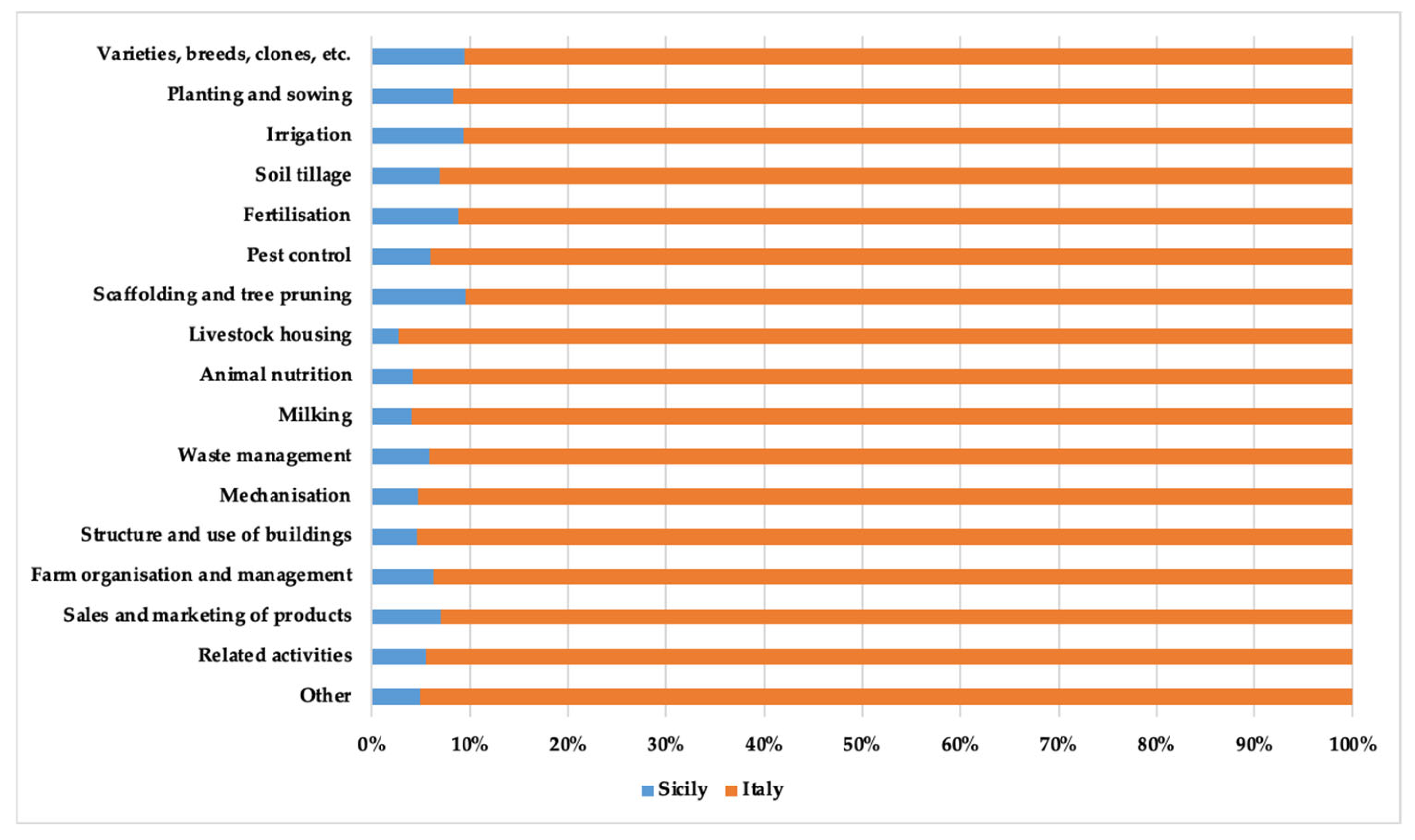
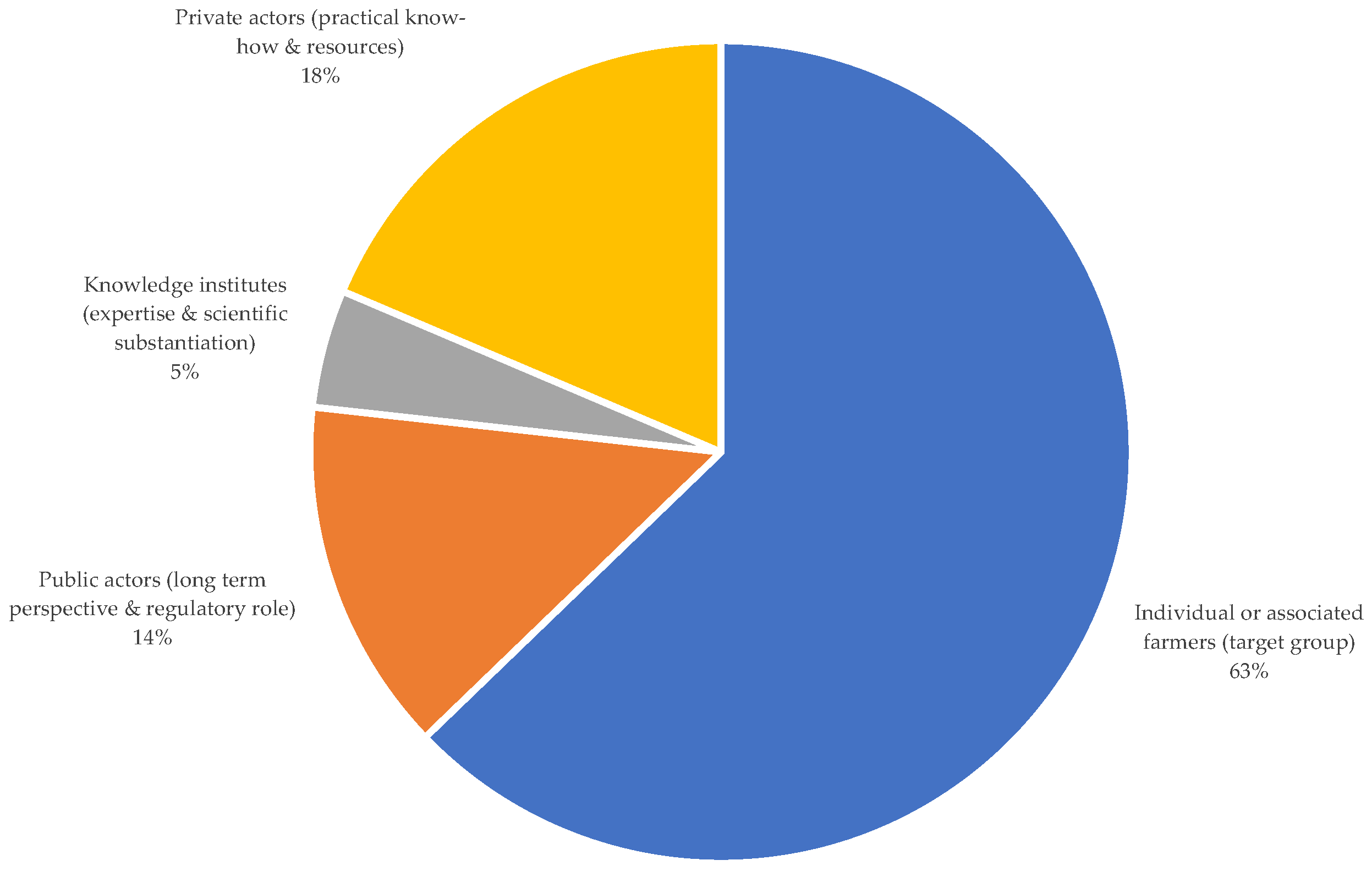
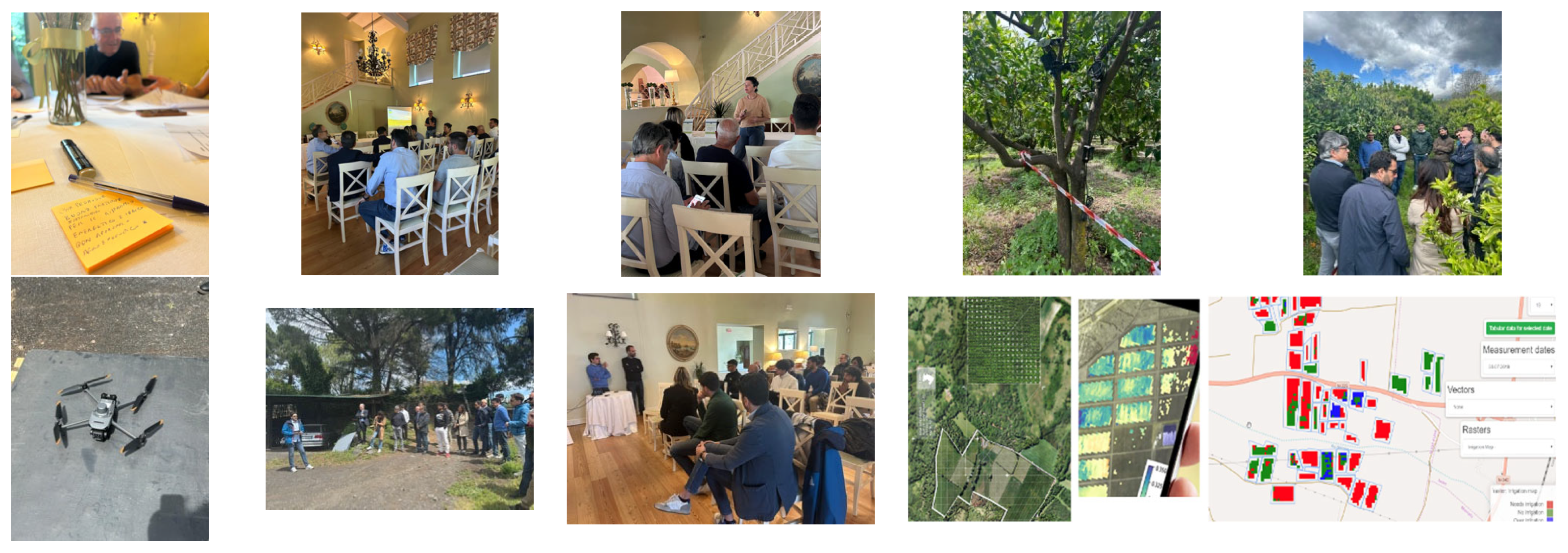


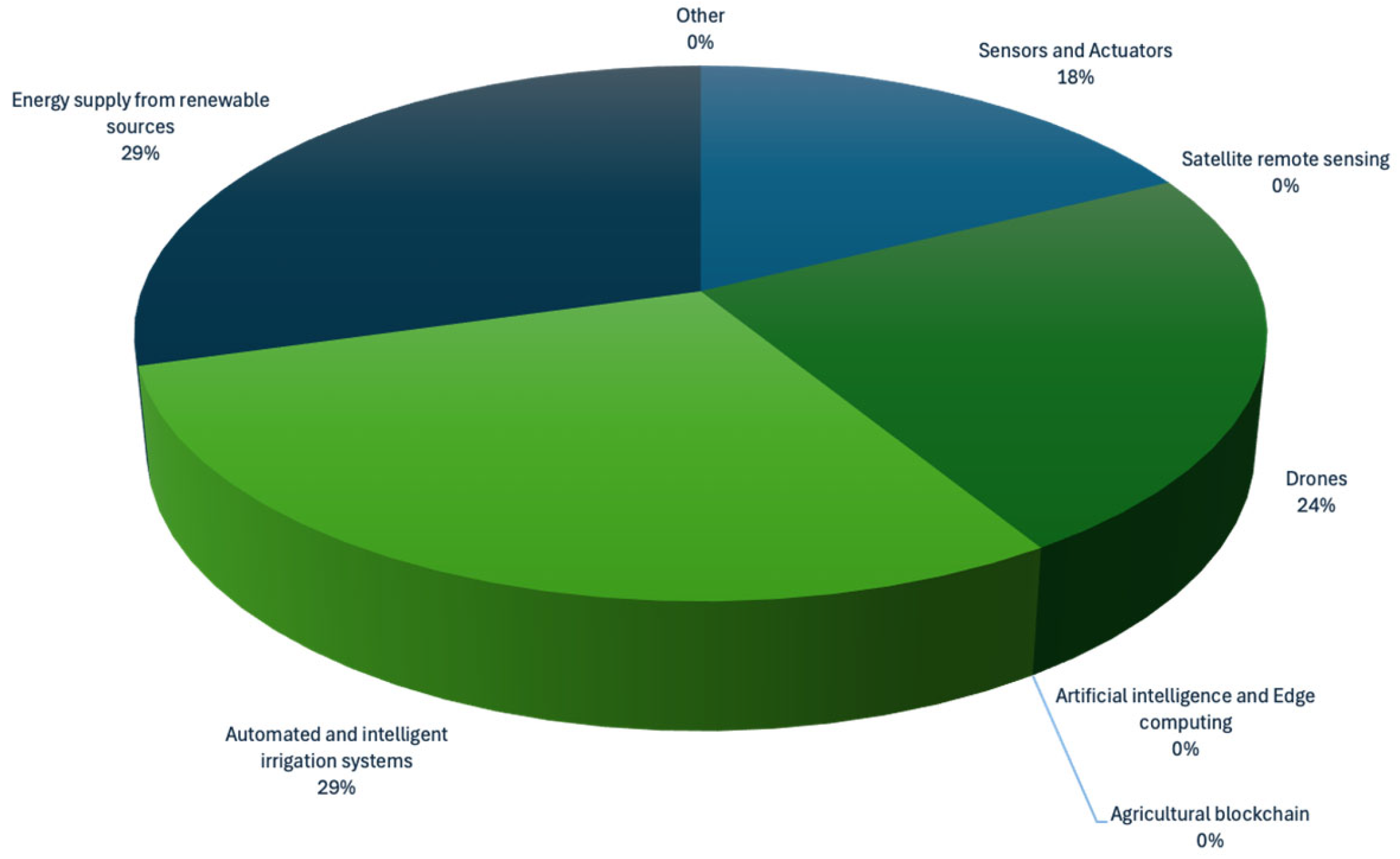
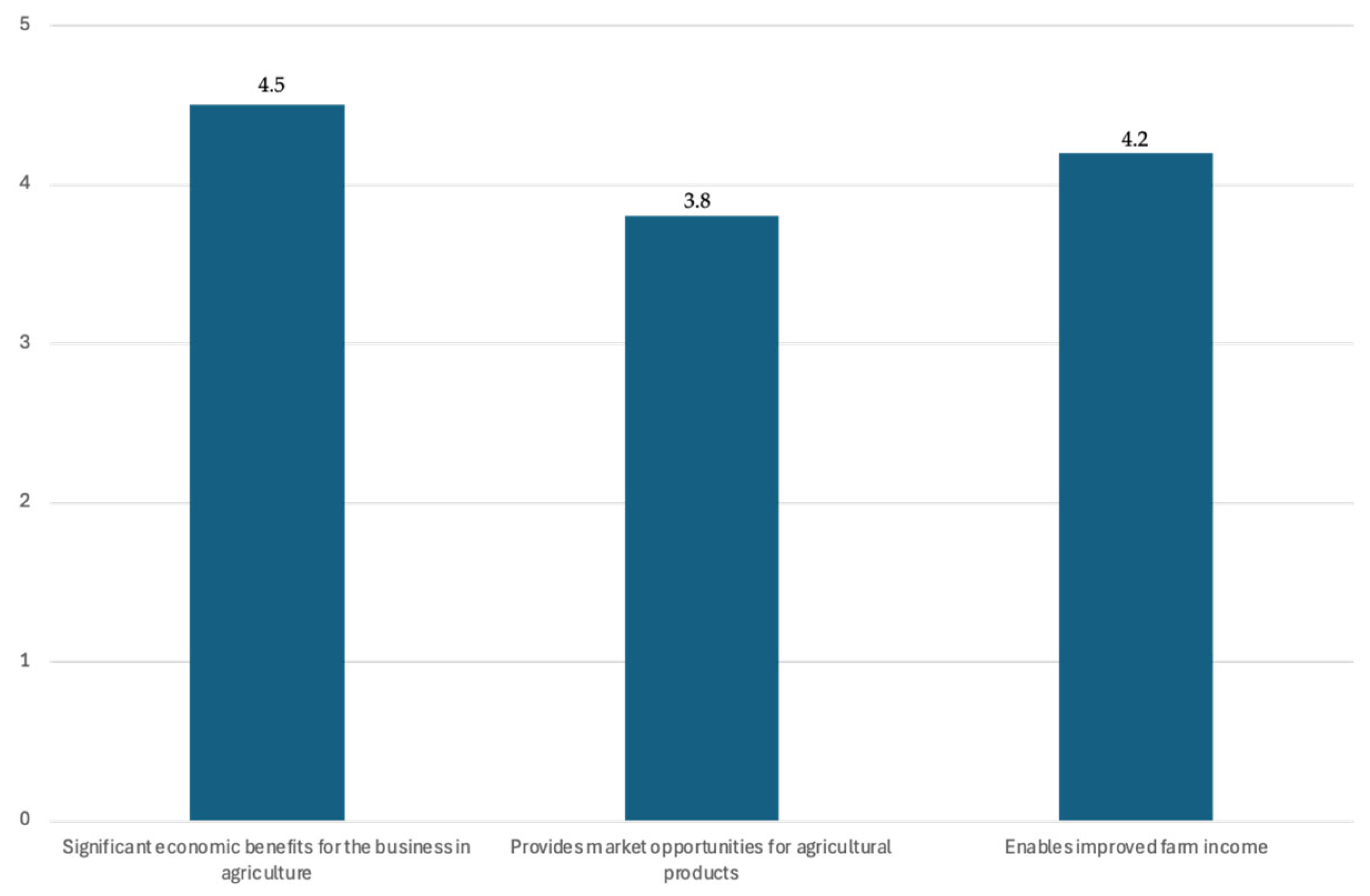



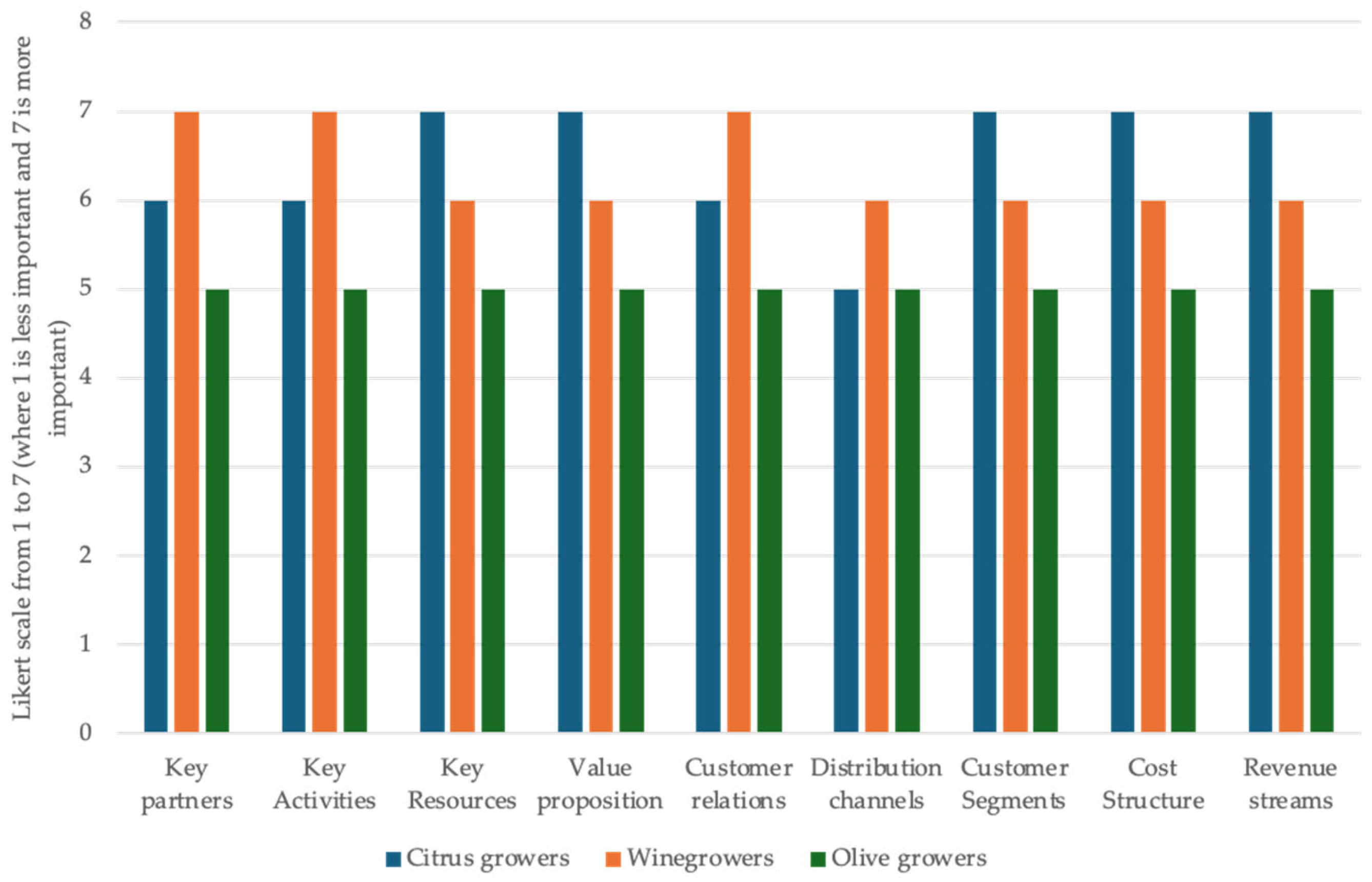
| Areas | Total Farms | Farms with at Least One Innovative Investment in the Three-Year Period, 2018–2020 | % |
|---|---|---|---|
| Sicily (a) | 142,416 | 8114 | 5.7 |
| Italy (b) | 1,133,023 | 124,904 | 11.0 |
| % (a)/(b) | 12.6 | 6.5 |
| All Farms | Innovative Farms | |||||||
|---|---|---|---|---|---|---|---|---|
| Areas | Total Farm, n. | AWU Classes | Total Farm, n. | AWU Classes | ||||
| 0 < AWU ≤ 1 | 1 < AWU ≤ 10 | AWU > 10 | 0 < AWU ≤ 1 | 1 < AWU ≤ 10 | AWU > 10 | |||
| Sicily, a | 142,416 | 123,563 | 18,409 | 358 | 8114 | 4792 | 3174 | 148 |
| 5.7 | 3.9 | 17.2 | 41.3 | |||||
| Italy, b | 1,133,023 | 912,938 | 214,117 | 3473 | 124,904 | 55,995 | 66,895 | 2014 |
| 11 | 6.1 | 31.2 | 58 | |||||
| % a/b | 12.6 | 13.5 | 8.6 | 10.3 | 6.5 | 8.6 | 4.7 | 7.3 |
Key partners:
| Key Activities:
| Value proposition:
| Customer relations:
| Customer segments:
|
Key resources:
| Distribution channels:
| |||
Cost structure:
| Revenue streams:
| |||
Disclaimer/Publisher’s Note: The statements, opinions and data contained in all publications are solely those of the individual author(s) and contributor(s) and not of MDPI and/or the editor(s). MDPI and/or the editor(s) disclaim responsibility for any injury to people or property resulting from any ideas, methods, instructions or products referred to in the content. |
© 2024 by the authors. Licensee MDPI, Basel, Switzerland. This article is an open access article distributed under the terms and conditions of the Creative Commons Attribution (CC BY) license (https://creativecommons.org/licenses/by/4.0/).
Share and Cite
Timpanaro, G.; Foti, V.T.; Cascone, G.; Trovato, M.; Grasso, A.; Vindigni, G. Living Lab for the Diffusion of Enabling Technologies in Agriculture: The Case of Sicily in the Mediterranean Context. Agriculture 2024, 14, 2347. https://doi.org/10.3390/agriculture14122347
Timpanaro G, Foti VT, Cascone G, Trovato M, Grasso A, Vindigni G. Living Lab for the Diffusion of Enabling Technologies in Agriculture: The Case of Sicily in the Mediterranean Context. Agriculture. 2024; 14(12):2347. https://doi.org/10.3390/agriculture14122347
Chicago/Turabian StyleTimpanaro, Giuseppe, Vera Teresa Foti, Giulio Cascone, Manuela Trovato, Alessandro Grasso, and Gabriella Vindigni. 2024. "Living Lab for the Diffusion of Enabling Technologies in Agriculture: The Case of Sicily in the Mediterranean Context" Agriculture 14, no. 12: 2347. https://doi.org/10.3390/agriculture14122347
APA StyleTimpanaro, G., Foti, V. T., Cascone, G., Trovato, M., Grasso, A., & Vindigni, G. (2024). Living Lab for the Diffusion of Enabling Technologies in Agriculture: The Case of Sicily in the Mediterranean Context. Agriculture, 14(12), 2347. https://doi.org/10.3390/agriculture14122347







